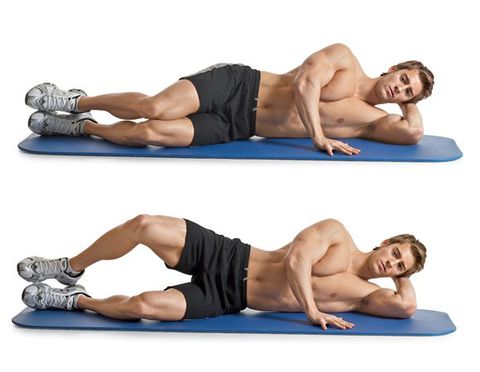Introduction
If you can’t sneeze, laugh, or cough without leaking some urine, you’re not alone. Pelvic floor issues are common and can affect anyone.
What’s the good news? Specific exercises (also known as pelvic floor muscle training) can assist strengthen your pelvic floor muscles while also reducing the severity of symptoms of pelvic organ prolapse.
Here’s a quick rundown of what the pelvic floor is, what it does, how to find these muscles, and when to seek expert treatment.
What exactly is the pelvic floor?
Muscles and connective tissue comprise the pelvic floor. These soft tissues attach to your pelvis, specifically the bones at the bottom of your pelvis.
The urethra, bladder, intestines, and rectum are all part of a person’s pelvic organs. The pelvic floor includes the uterus, cervix, and vagina if you have one.
According to Marcy Crouch, PT, DPT, WCS, a board-certified clinical specialist in women’s health, seeing the pelvic floor muscles as a hammock or baskets at the bottom of the pelvis is an ideal way to comprehend their function.

“When you engage or clench your pelvic floor, it causes a lifting action toward your head, which feels like you’re trying to stop gas or urine or pucker your anal orifice,” she says.
What is the pelvic floor’s function?
The pelvic floor muscles are necessary for everyday tasks. The pelvic organs, which include the bladder, urethra, rectum, anus, prostate, uterus, cervix, vagina, and intestines, are supported by them.
Pelvic floor muscles are also involved in sexual health and function, including arousal and orgasm. Furthermore, they help to stabilize your hips and trunk, especially when walking and standing.
Pregnancy and vaginal birth can weaken these muscles, causing everything from minor pain and discomfort to pelvic organ prolapse.
Pelvic floor dysfunction, on the other hand, is not confined to pregnancy or childbirth. Age, menopause, surgery, recurrent heavy lifting, extended sitting, sexual assault, or circumstances that exert strain on the abdomen, such as pregnancy, can all contribute to abdominal pain.
Furthermore, endometriosis, irritable bowel syndrome, interstitial cystitis, and regular tendencies of avoiding or restricting bowel movements can all contribute to pelvic floor diseases (PFD).
Are these muscles found in both sexes?
Many people associate Kegels and the pelvic floor with the vagina and, more specifically, pregnancy.
You might be shocked to learn that people of both sexes have these muscles. In people who have a penis, the pelvic floor muscles support the bladder and colon, preventing stool and urine incontinence.
They also help with sexual health issues like function and sensation. Chronic prostatitis, pudendal neuralgia, genitofemoral neuralgia, and hypertonicity are the most common diagnoses of men’s pelvic floor disorders.
Where are the pelvic floor muscles located?
Stopping or reducing urine flow when going to the restroom is one of the simplest ways to detect the pelvic floor. You’ve identified your pelvic floor if you can perform this successfully at least a few times.
Crouch recommends the following exercise to stimulate the pelvic floor muscles:
- Lie on your back with your legs bent and your feet flat on the floor. Inhale.
- Exhale slowly, drawing in your lower abdominal muscles and compressing the muscles around your urethra as if you were trying to block the flow of gas or urine. People who have vaginal prolapse may also concentrate on lifting or compressing the muscles that surround the vagina.
- Hold everything for 1-2 seconds before releasing. Sink your pelvic floor muscles and relax them.

Assume you need to pass gas but prefer not to do so while standing in order to identify the pelvic floor muscles.
If you try to hold it in, you’re more likely to compress your rectum and anus. If you experience a pulling sensation around your anus, you are engaging the pelvic floor muscles.
Remember that the pelvic floor muscles reach across the bottom of your pelvis when you contract them. If you only contract the muscles that control urine flow but not the rectal muscles, you will not get a full contraction.
Engage both regions – the muscles that would halt both gas and urine – for the most efficient contraction. It has also been demonstrated that simultaneously strengthening the transversus abdominis and obliques helps to deepen pelvic floor muscle activation.
Similarly, exercising the pelvic floor muscles may help to strengthen abdominal contraction. This is especially true if you are an athlete or want to improve your core for functional reasons.
Learning to release or relax the contractions of these muscles, on the other hand, is necessary for optimal pelvic floor function. After you sense the sensation of contraction in these muscles, check in with yourself on a regular basis: Is it normal for particular muscles to be slightly active?
Excessive tension on these muscles might result in pain, therefore learning to let the elevator rest at the bottom is also essential.
What is pelvic floor dysfunction, and how common is it?
It’s impossible to say how many people have pelvic floor issues because awareness of the symptoms and illnesses is low. Many women assume that pelvic floor dysfunction is a normal aspect of childbirth or ageing, thus they do not seek treatment.
Pelvic floor problems occur when the pelvic floor muscles weaken or fail, allowing the pelvic organs to become unsupported. Urine or faecal incontinence, urgency urinary incontinence, overactive bladder, and pelvic organ prolapse are symptoms of these disorders.
However, one in every four women is thought to suffer from pelvic floor illness, and that number more than doubles by the time women reach the age of 80. PFD affects more than half of all women during their reproductive years, according to certain research.
Furthermore, scientists predict that the number of women affected with PFD would increase by 70% by 2050 due to health conditions such as rising BMI and chronic constipation.
Furthermore, although the prevalence of such conditions in men is estimated to be around 16%, people with a penis are less inclined to believe that PFD could harm them.
Pelvic floor dysfunction symptoms include:
- fullness or pelvic pressure
- a constant need to urinate or painful urination
- leaking of pee
- incontinence due to urine
- lower back ache
- bowel leaks, constipation, or intestinal obstruction
- bladder emptying issues
- Sexual action is unpleasant.
- pain in the pelvic or genital region
- Spasms in the pelvic muscles

There are, thankfully, nonsurgical treatments available to cure PFD and alleviate discomfort or humiliation. A pelvic floor physical therapist consultation is typically a wonderful place to start.
Is my pelvic floor tight or loose?
Chronic pelvic floor disorders can be caused by hypotonic (too lax or weak pelvic floor muscles) or hypertonic (too tight or tight pelvic floor muscles) pelvic floor muscles (too tight or overactive pelvic floor muscles).
These symptoms are also referred to as nonrelaxing and relaxing pelvic floor dysfunction. Pelvic floor dysfunction can cause both hypotonic and hypertonic symptoms. Patients who believe their pelvic floor issues are caused by inert muscles are typically astounded by this.
The pelvic floor is made up of skeletal muscle. “That means it can withstand the same types of damage, weakness, or stress as any other muscle in your body,” Crouch says. “It can also become “tight” or persistently restricted, much like a calf muscle spasm.”
According to Crouch, if the muscles are in spasm, restricted, or too tight, performing Kegels may aggravate the problem – discomfort, leaking, constipation, or sexual dysfunction. To put it another way, if you have a hypertonic pelvic floor, you should avoid Kegels until you consult a pelvic floor physical therapist.
Pelvic floor strengthening exercises
The pelvic floor can be engaged at any moment and from any location. In contrast, incorporating specific activities that strengthen and target the pelvic floor muscles is beneficial.
One method for designing a program is to divide the workouts into hypotonic and hypertonic pelvic floor muscles. Crouch characterizes hypotonia as pelvic floor disorders requiring strengthening, endurance, and power.
Exercises for hypotonic pelvic floor muscles
To target hypotonic pelvic floor issues, Crouch recommends these 3 exercises:
Kegels with quick flicks
- Crouch describes the fast flick. Kegel necessitates quick pelvic floor contractions to assist in activating the muscles faster and harder in order to stop leaks during sneezing or coughing.
- Begin by lying on your back with your knees bent and your feet flat on the ground. As you feel more comfortable with this exercise, do it sitting or standing.
- Using the recommendations above, locate your pelvic floor muscles.
- Exhale, draw your navel to your spine and tighten and relax your pelvic floor muscles swiftly. Aim for a one-second contraction followed by a one-second relaxation.
- Maintain a steady breathing pattern throughout.
- Repeat the rapid flip 10 more times, then rest.

Heel slides
Heel slides work the deep abdominal muscles as well as the pelvic floor muscles.
- Begin by lying flat on your back, legs bent and pelvis neutral.
- Inhale deeply into your rib cage, then exhale through your mouth, letting your ribcage naturally collapse.
- Pull your right heel away from you while drawing your pelvic floor up.
- Go as far as you can without losing sight of yourself.
- Find your lowest position, inhale, and return your leg to where it started. Repeat.
- Perform 10 slides on each side before moving to the opposing leg.
Marches (also called toe taps)
Like heel slides, marching increases core stability and stimulates pelvic floor contractions.
- Begin by lying down on your back with your legs bent and your pelvis neutral.
- After inhaling into your rib cage and letting your ribs naturally contract, exhale through your lips.
- Tighten your abs and draw your pelvic floor up.
- Slowly raise one leg to a tabletop position.
- Slowly return this leg to the beginning position.
- Rep the exercise with the opposite leg. Your lower back should be free of pain. It’s crucial to keep your deep core engaged throughout the workout.
- Alter the legs 12-20 times total.
Pelvic floor muscle hypertonicity exercises
If you have a short or tight pelvic floor, hypertonic workouts may help you relax and stretch it. Crouch explains that the idea is to stretch and relax the hypertonic muscles so that contractions are more effective and the muscles can function properly.
“We have to make sure the muscle can perform what we need it to do,” she adds, adding that “lengthening is equally as vital as strengthening.” She suggests the following exercises:
Happy Baby Pose
The Happy Baby Pose is an excellent addition to a pelvic floor workout for stretching and releasing.
- Begin by lying on the floor, knees bent.
- With the soles of your feet pointing up, make a 90-degree angle with your knees toward your torso.
- Keep your hands on the outside or inside of your feet.
- Make your knees slightly wider than your body. After that, raise your feet to the level of your armpits. Check to see if your ankles are higher than your knees.
- Push your feet into your hands and flex your heels. You can hold this position for several breaths or rock from side to side.

Diaphragmatic breathing
Diaphragmatic breathing strengthens the functional link between the diaphragm and the pelvic floor. It’s also an excellent stress-reduction workout.
- Begin by lying down on the floor on a yoga or exercise mat. You can also do the exercise while sitting.
- For a few seconds, practice progressive relaxation. Focus on relaxing your muscles.
- Once you’ve relaxed, place one hand on your tummy and the other on your chest.
- Inhale through your nose to expand your stomach while maintaining your chest still. Then, inhale for 2-3 seconds before exhaling gently.
- Rep with one hand on the chest and the other on the stomach several times.
Crouch also recommends including lunges and squats in pelvic floor practice. “Everyday activities like lunging and Swiss ball squats can be excellent ways to incorporate pelvic floor training,” she says.
Crouch suggests contracting the pelvic floor before entering a lunge or squat, re-engaging at the bottom, and then contracting again as you drive up to standing.
To summarize
Incorporating pelvic floor strengthening exercises into your regular routine is an excellent way to develop these muscles while also improving your overall health. Keep form and function in mind when executing an exercise, as well as stimulating the muscles.
If you’re new to these exercises or need further help, consult a pelvic floor physical therapist. They can make specific recommendations and ensure that you follow them correctly.
Finally, if your symptoms are interfering with your everyday activities or appear to be becoming worse, see your doctor.
